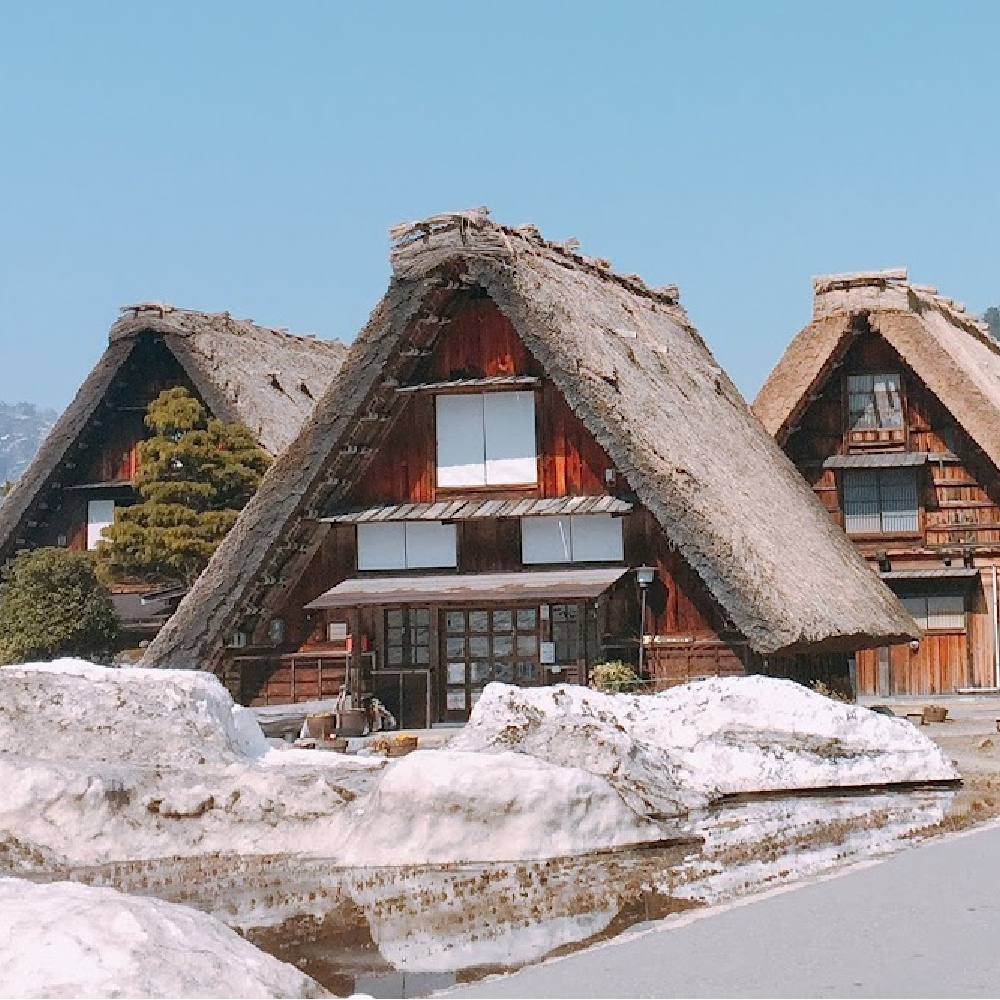A Slow March Journey by Train through Japan’s Alps. From Tokyo to Takayama, Shirakawa-go, Matsumoto & Nagano
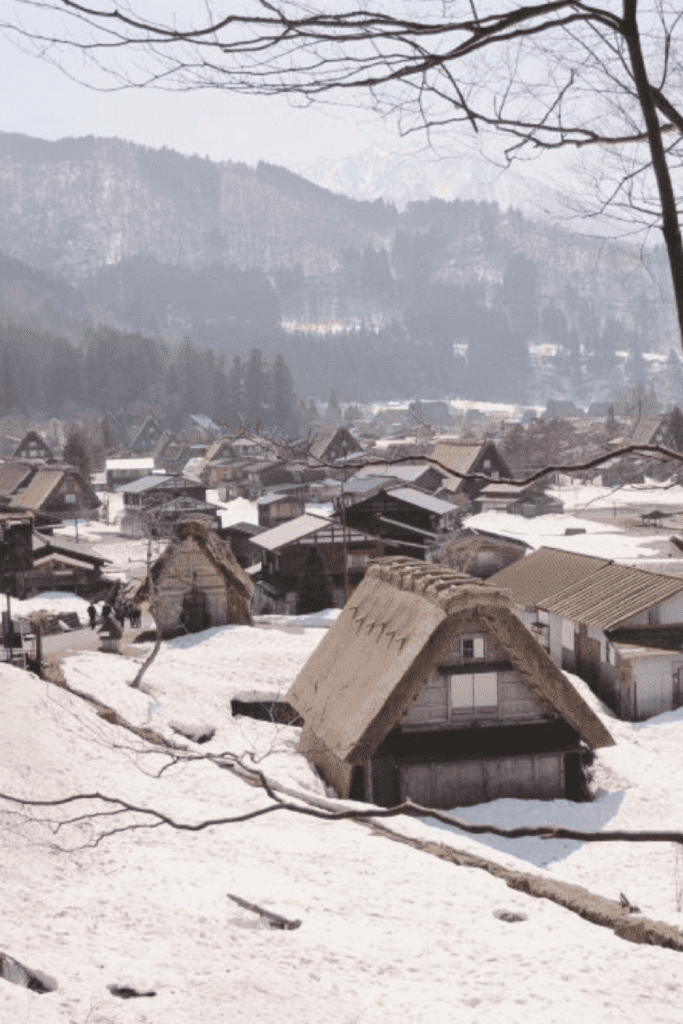
Want to see Japan’s hidden alpine towns, temples, and snow monkeys — without renting a car?
Here’s a peaceful, train-based itinerary through Central Japan in March.
📍 Quick Itinerary Summary
Day 1
• Tokyo ➝ Takayama (by train)
• Takayama ➝ Shirakawa-go (by bus)
• Return to Takayama (overnight)
Day 2
• Takayama ➝ Matsumoto (by train)
• Explore Matsumoto (overnight)
Day 3
• Matsumoto ➝ Nagano (by train)
• Visit Snow Monkey Park (by bus)
• Explore Zenko-ji Temple (overnight)
Day 4
• Visit Togakushi Shrine (by bus)
• Nagano ➝ Tokyo (by train)
March Train Itinerary Through Japan: Nagano, Matsumoto & Takayama
Day 1: Tokyo → Takayama → Shirakawa-go
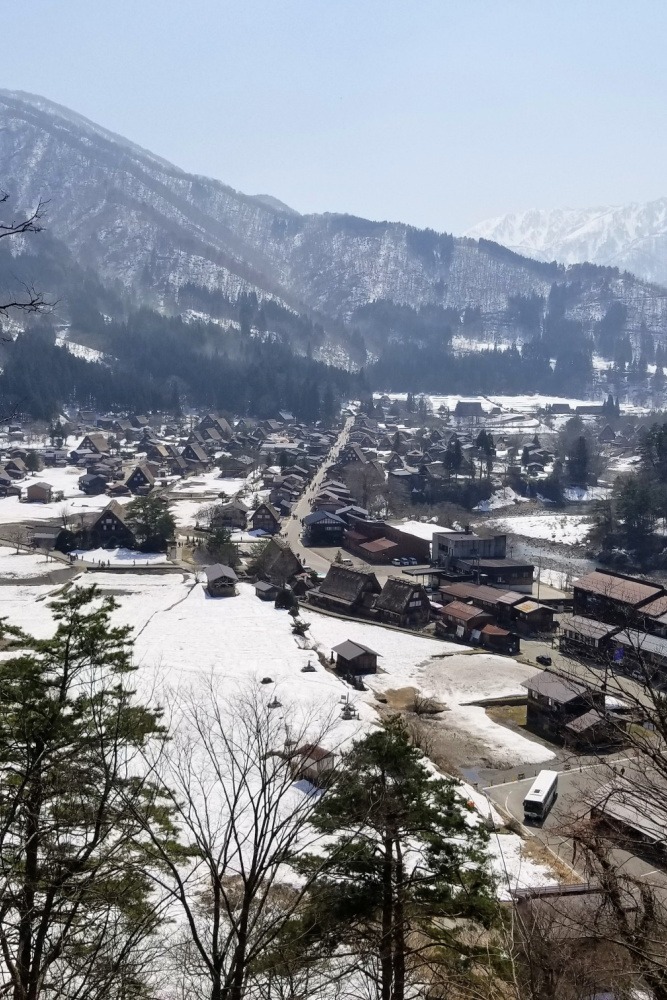
Shirakawa-go in late March
After a morning train ride from Tokyo to Takayama — with a quick stop to leave my bag in a station locker — I boarded the bus to Shirakawa-go 1. I arrived in the village on a sunny March morning. After stepping off the bus, I chose a longer but quieter path
Deep snow covered the trail, and my feet sank to my knees with every step.
However, the effort was worth it. At the end of the walk, Shirakawa-go welcomed us with a spectacular view of the romantic village, nestled in a valley at the foot of the mountains, surrounded by majestic cedar trees dusted with snow.
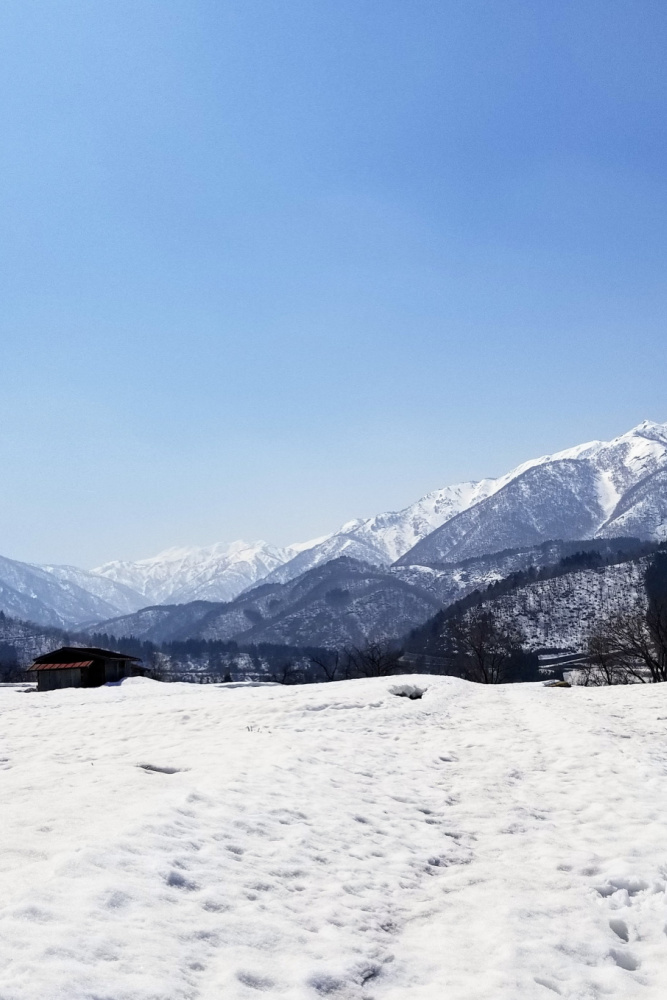
Snow in Shirakawa-go in late March
It’s no surprise that UNESCO has recognized the village as a World Heritage Site.
The town is famous for its thatched-roof houses, which artisans built in the gassho-zukuri style.
Shirakawa-go is especially popular in January and February when thousands of visitors arrive on weekends to witness the fully illuminated village during the Light Up Event.
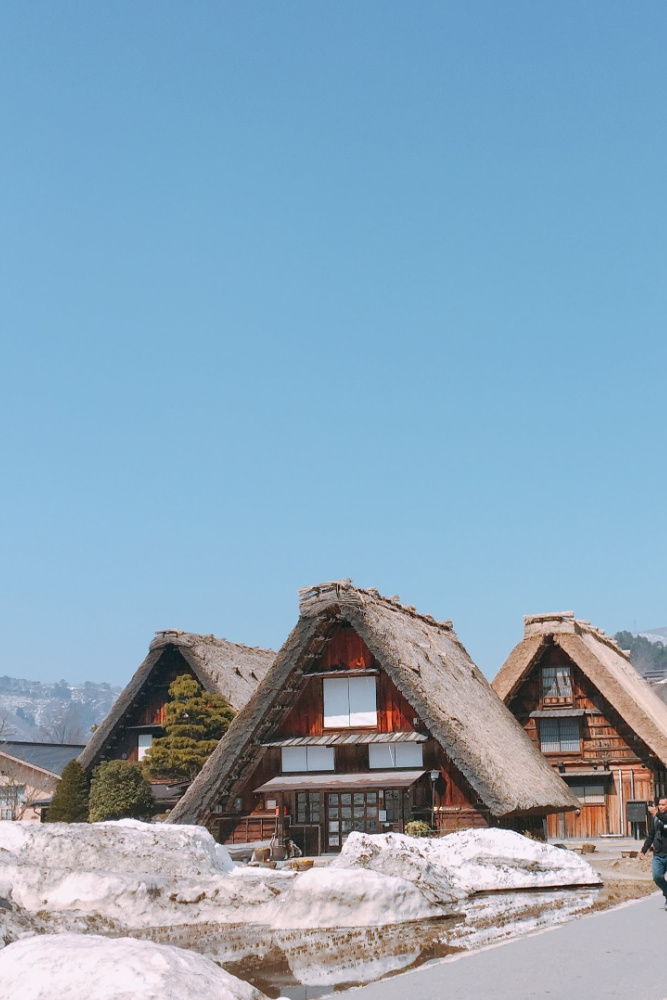
Thatched-roof houses
Although Shirakawa-go can sometimes feel touristy, this does not diminish its authenticity.
Walking through it is a fantastic way to immerse yourself in Japan’s traditional way of life.
As I strolled through the village, I wandered among the wooden, thatched-roof houses scattered throughout.
The main street divided the town into two parts. On either side were restaurants, cafés, small food stalls selling traditional snacks, and souvenir shops, where locals warmly welcomed visitors.
Though staying overnight in the village would have been a magical experience, by midday, we returned to Takayama.
After picking up our things from the station locker, we set out to explore the historic city center.
If you love exploring cities filled with history and tradition, don’t miss the Charming City of Gyeongju in South Korea—a place where ancient temples and royal tombs meet daily life.
Afternoon: Exploring Takayama’s Historic Center
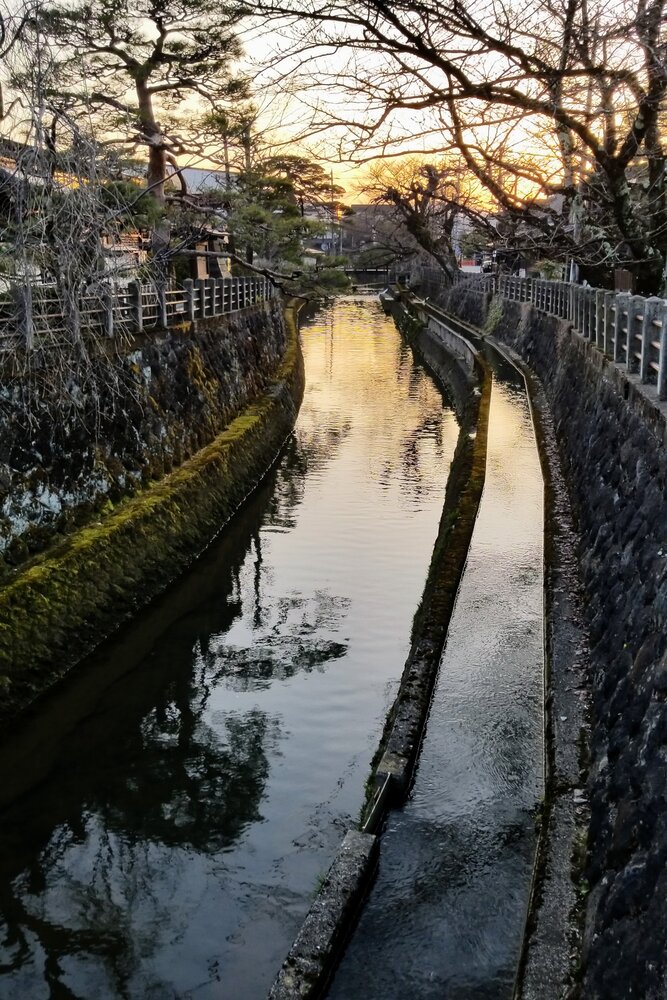
The river in Takayama
Takayama is an ancient city from the 16th century, surrounded by the Japanese Alps.
We walked along the river searching for temples and shrines from the Edo period.
The afternoon was sunny, and the sky was a brilliant blue, but the air was icy cold.
Looking for warmth, we stumbled upon a small artisanal sake brewery.

Takayama’s historic center
The brewery owner, a kind Japanese gentleman, welcomed us with a smile.
He explained the sake-making process in English with great patience and pride.
He told us how they carefully selected the rice and how long the fermentation process took in the large green tanks to achieve the perfect balance.
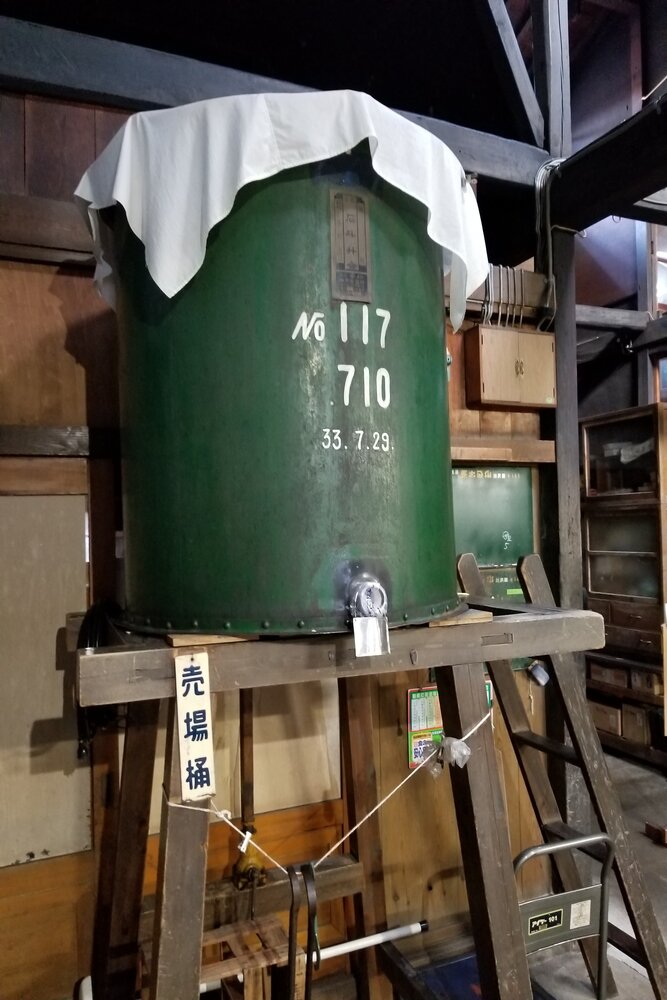
Sake fermentation tank
He passionately shared details about his craft and invited us to taste different types of sake.
I had already tried a few, but my favorite was a smooth, fruity peach sake.
Its sweetness made it incredibly easy to drink, masking its high alcohol content.
The cold air felt less harsh as we left the brewery, still warm from the sake and slightly unsteady on our feet.
For nature lovers heading to Taiwan, I highly recommend the Yangmingshan Hike to Qixing Mountain—a scenic trail through volcanic terrain with epic views.
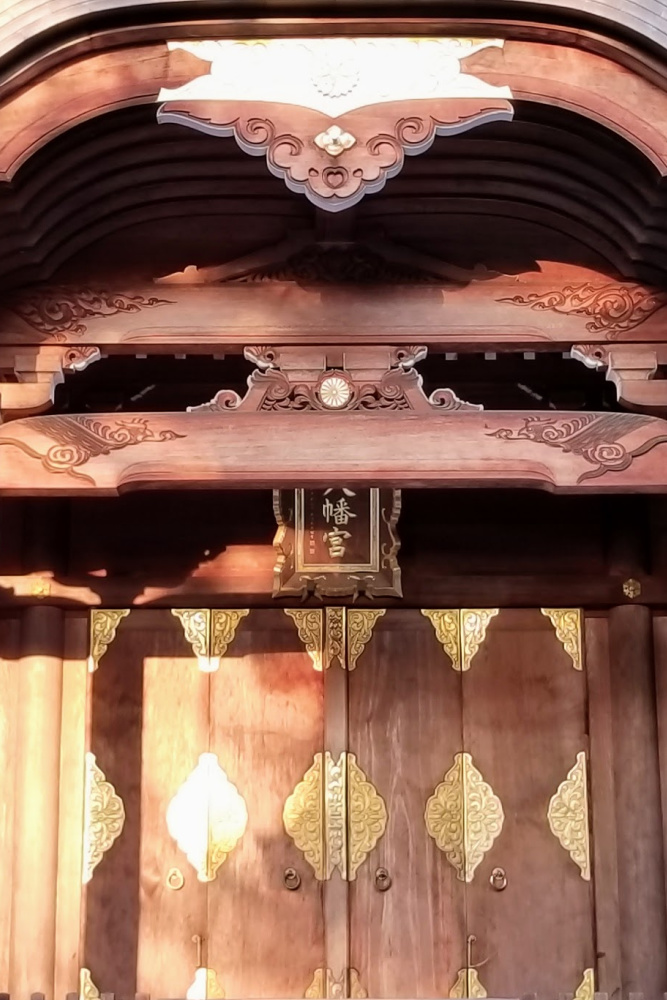
Wooden details at Sakurayama Hachimangu Shrine
We wandered through the streets of Takayama, passing dark wooden facades, soft lantern lights, and the towering mountains as our backdrop.
Our walk led us to Sakurayama Hachimangu, a Shinto shrine—a peaceful place for reflection and showcasing the incredible craftsmanship of the region’s carpenters.
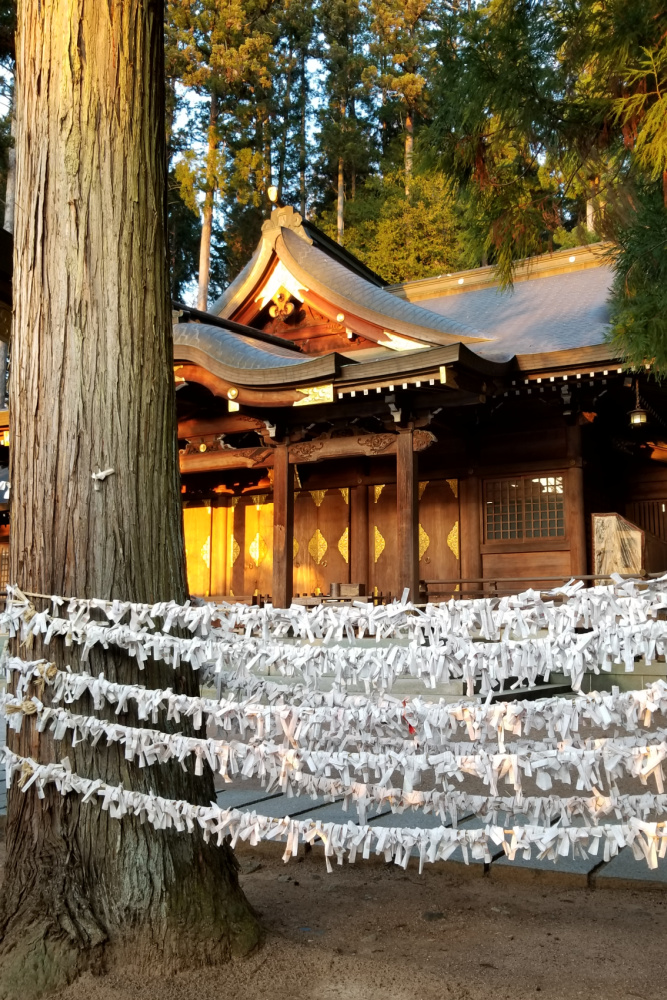
Omikuji at Sakurayama Hachimangu Shrine
Hundreds of white paper strips fluttered in the wind between the thick trunks of ancient cedars.
I learned that these were omikuji, fortune predictions left by visitors hoping to attract good luck or ward off bad luck.
We enjoyed a delicious dinner at a local izakaya and spent the night in Takayama before continuing our journey to Matsumoto the following day.
Day 2: Takayama → Matsumoto – A Castle Town with Artistic Soul

Decorated utility hole covers in Matsumoto
The next morning, we boarded the train toward Matsumoto, known for its iconic black castle and connection to artist Yayoi Kusama.
We noticed the beautifully decorated utility hole covers as we crossed the river searching for Matsumoto Castle—nicknamed the “Black Crow” due to its elegant dark structure.
Their colorful designs reminded me of the artwork of Yayoi Kusama, who was born in this city and has a permanent exhibition at the Matsumoto City Museum of Art.
We had visited Himeji Castle on our first trip to Japan and were eager to see Matsumoto Castle.
Built-in the late 16th century, it is one of Japan’s oldest and best-preserved castles. But the surrounding area was just as enjoyable to explore.
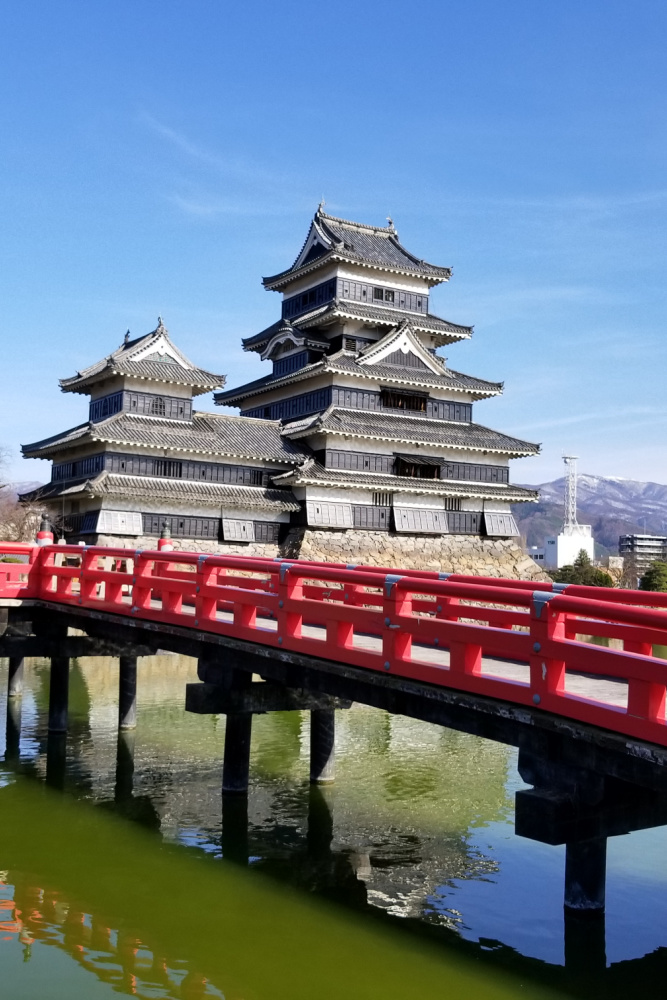
Matsumoto Castle
We sat on a bench, watching the curious carp emerge from the water with their mouths open, hoping for breadcrumbs.
Wandering through Matsumoto’s streets, we stumbled upon a small soba restaurant.
The place was simple and rustic—perfect for lunch. The open kitchen allowed us to watch the chefs boil freshly harvested buckwheat noodles in large pots.
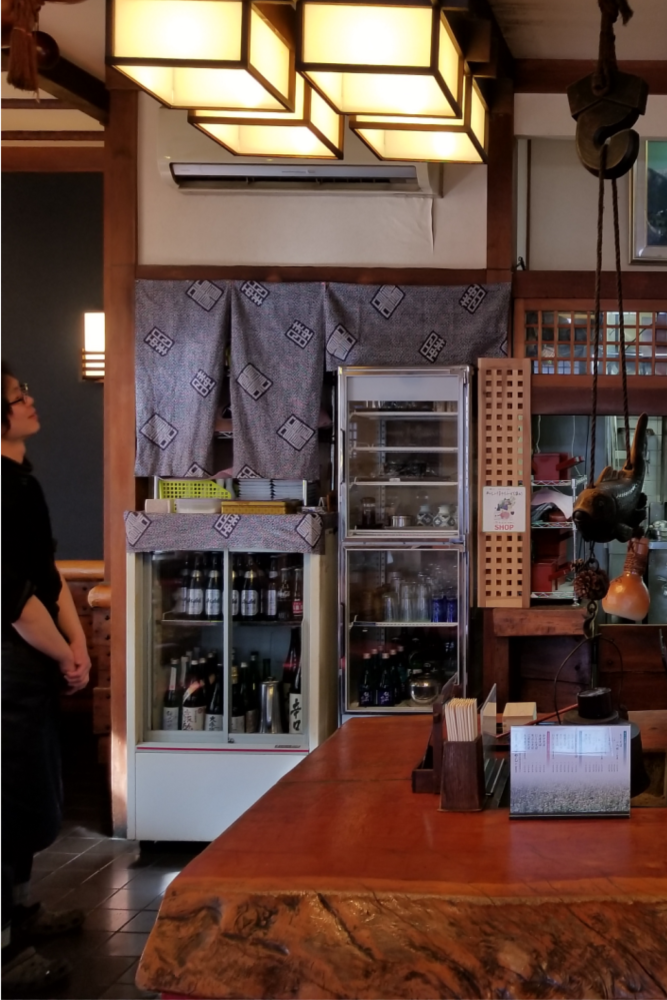
Soba restaurant in Matsumoto
We sat at a long wooden table and enjoyed a steaming bowl of soba with crispy vegetable tempura, delicately garnished with a carrot flower.
The Japanese pay close attention to every detail in food presentation!
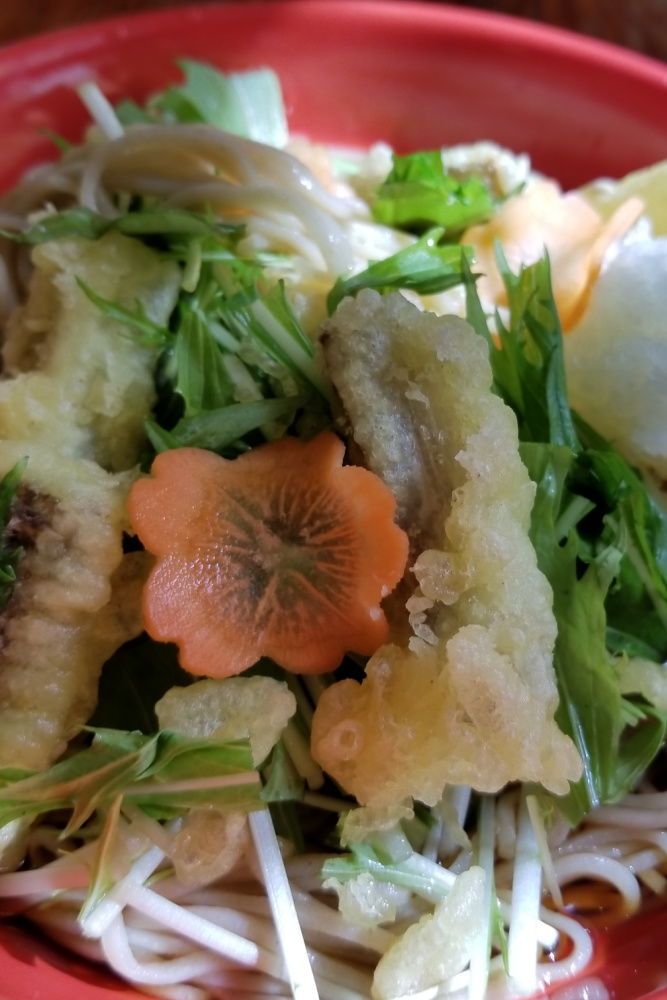
Soba with tempura in a Matsumoto restaurant
We sat at a long wooden table and enjoyed a steaming bowl of soba with crispy vegetable tempura, delicately garnished with a carrot flower.
The Japanese pay close attention to every detail in food presentation!
Day 3: Matsumoto → Nagano – Monkeys, Temples & Mountain Shrines
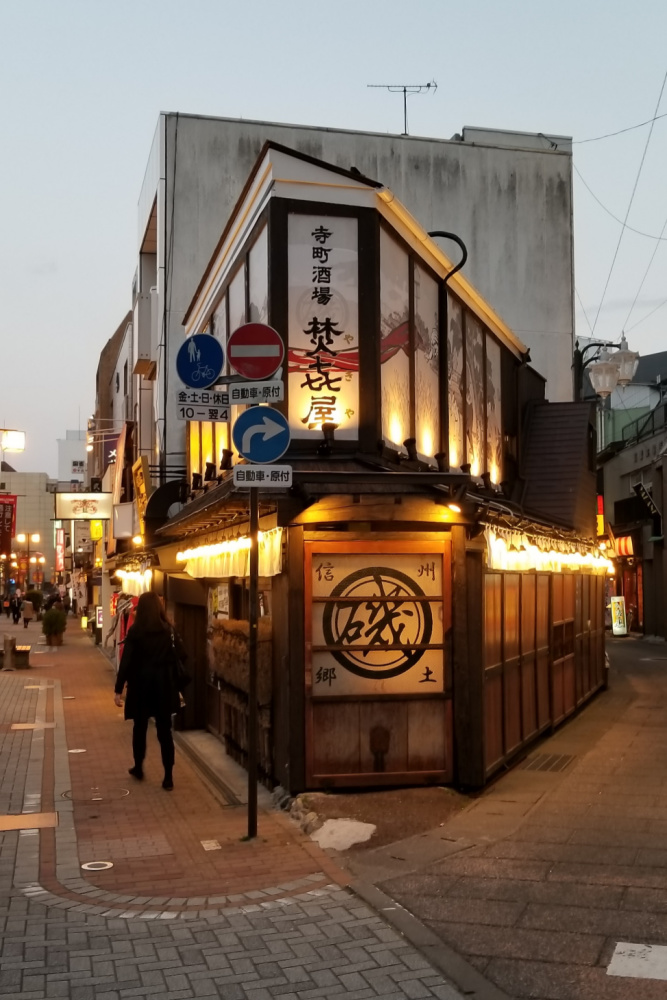
The city of Nagano
That morning, we boarded a scenic train from Matsumoto to Nagano, enjoying the peaceful countryside views along the way.
We based ourselves in Nagano for two nights to explore some of the region’s highlights — from snow monkeys bathing in hot springs to sacred temples tucked away in the mountains.
Nagano is a modern city with a wide range of hotels, making it an excellent place to stay.
From there, public transport was very convenient for exploring the region.
Late Morning: The Jigokudani Snow Monkeys
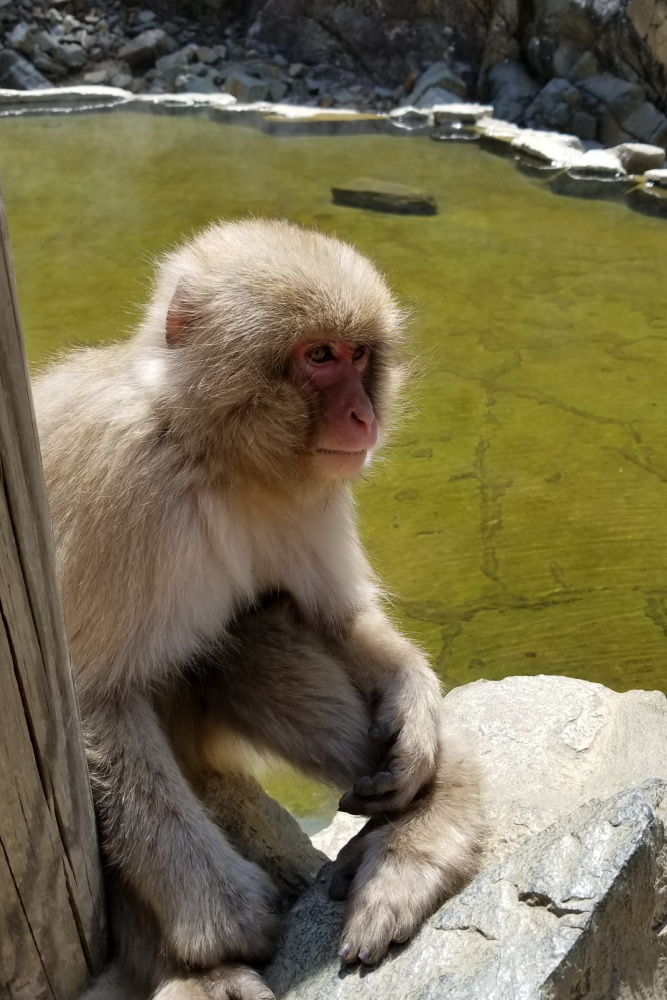
Jigokudani macaques in Nagano
We set out to see the famous Jigokudani macaques—the ones we had seen in documentaries, surrounded by snow and soaking in hot springs.
These monkeys live in one of Japan’s coldest areas and have learned to escape the winter chill by bathing in the park’s thermal waters.
Although we didn’t find snow upon arrival, the bright sun illuminated the landscape, and families of macaques roamed freely, entirely accustomed to visitors and their cameras.
Afternoon: Zenko-ji Temple
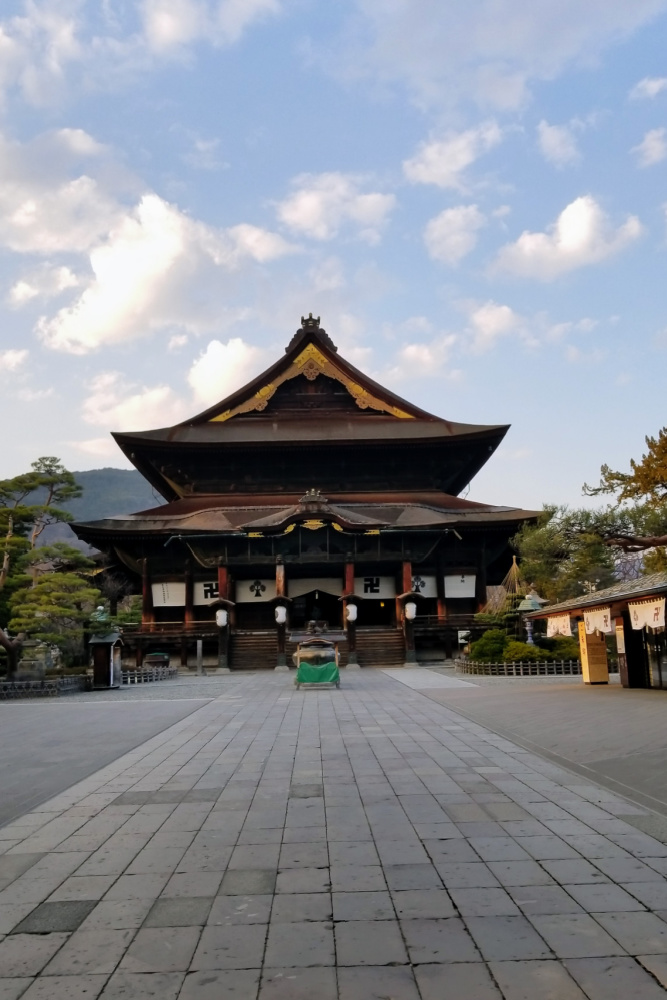
Zenko-ji Temple
In Nagano, we also visited Zenko-ji Temple, one of Japan’s most important and ancient Buddhist temples.
We walked down a street lined with traditional shops selling souvenirs, amulets, and local sweets to reach it.
Love historic cities? Discover The Charming City of Gyeongju, a cultural gem in South Korea!
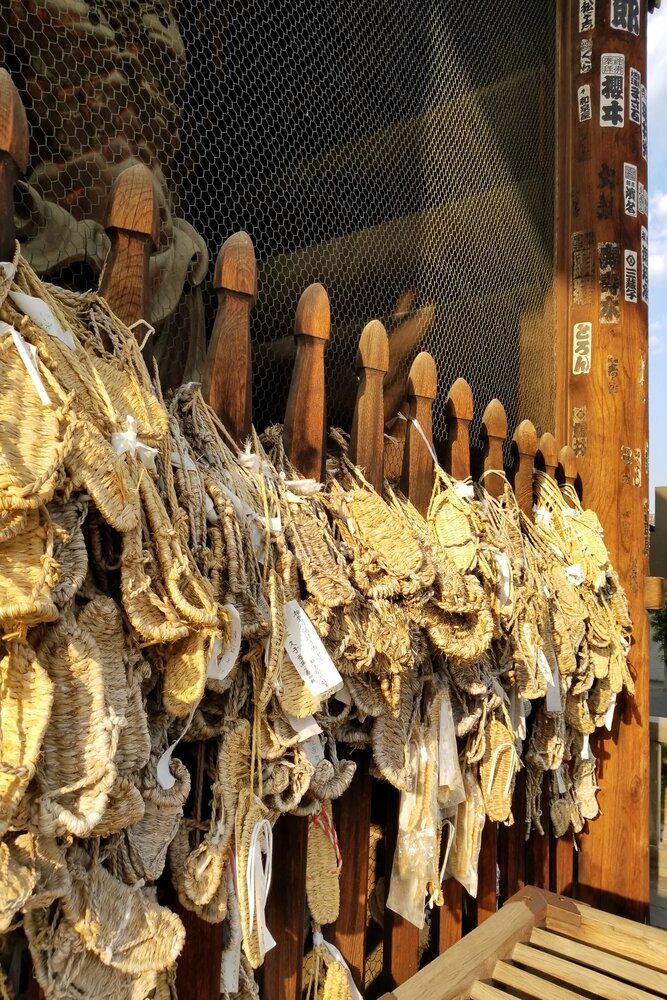
Waraji sandals along the path to Zenko-ji Temple
I noticed a small corner filled with carefully hung straw sandals (waraji) on a wooden fence along the way.
Pilgrims once wore these sandals while traveling long distances to temples.
People say that leaving them behind serves as an offering for protection during travels or a gesture of gratitude for a safe journey.
Looking for coastal views in Asia? The Dragon’s Back Hike in Hong Kong offers some of the region’s best panoramas and an unforgettable ridge walk.
Day 4: Nagano → Togakushi Shrine → Tokyo
Morning: Togakushi Jinja Shrine
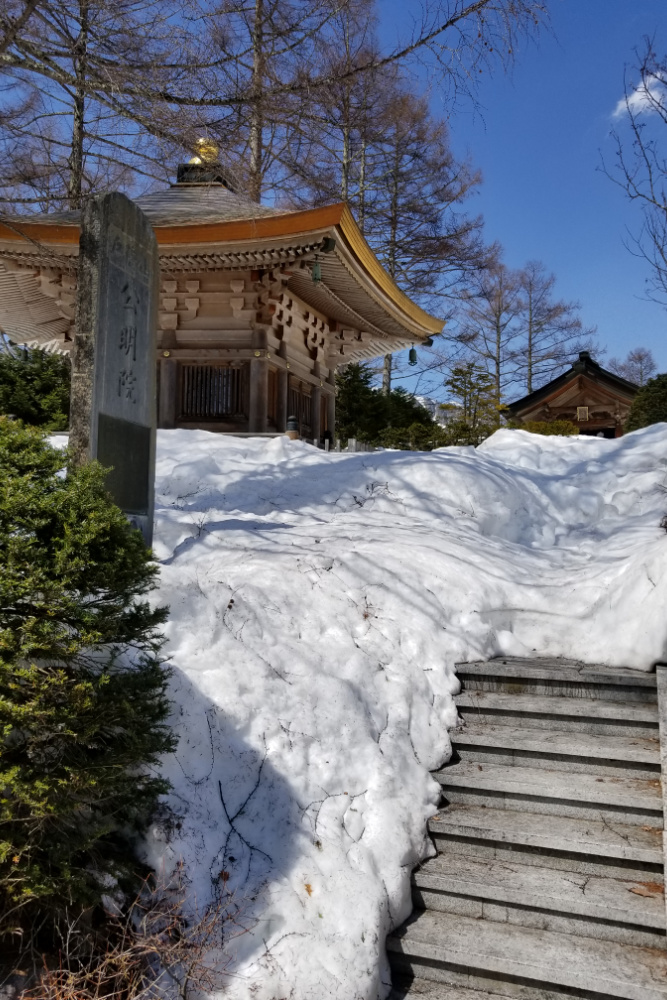
Togakushi Jinja Shrine
In search of nature, we traveled to the mountains for a little over half an hour and visited Togakushi Jinja Shrine.
The contrast with the urban landscape was incredible—snow covered the ground, and majestic cedar trees stood tall against the blue sky.
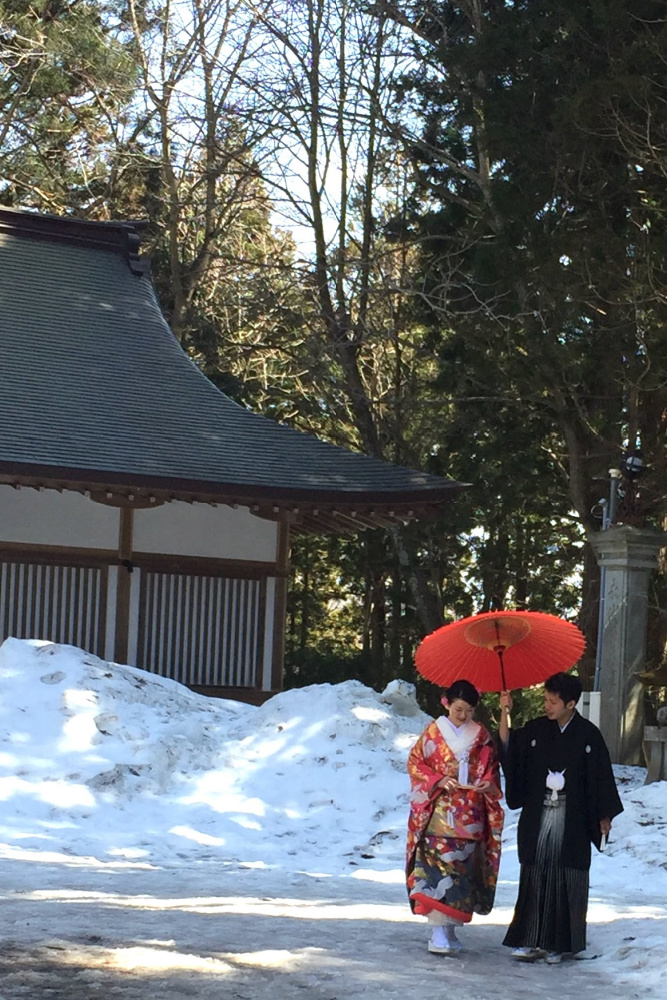
The surroundings of Togakushi Jinja Shrine
As we explored the area, we saw a couple emerging from the shrine dressed in traditional attire.
She wore a colorful kimono, while he donned an elegant black montsuki.
He held a delicate red parasol with great care as they walked carefully over the slippery snow, maintaining a steady pace despite wearing traditional Japanese sandals.
Looking for more sustainable travel tips? Check out How to Choose a Sustainable Accommodation for eco-conscious stays.
Afternoon: Return to Tokyo
After lunch, we took the train back to Tokyo. The ride gave us time to reflect on this four-day adventure—filled with scenic landscapes, warm encounters, and a slower, more intentional way to travel through Japan.
Traveling by Train in Japan
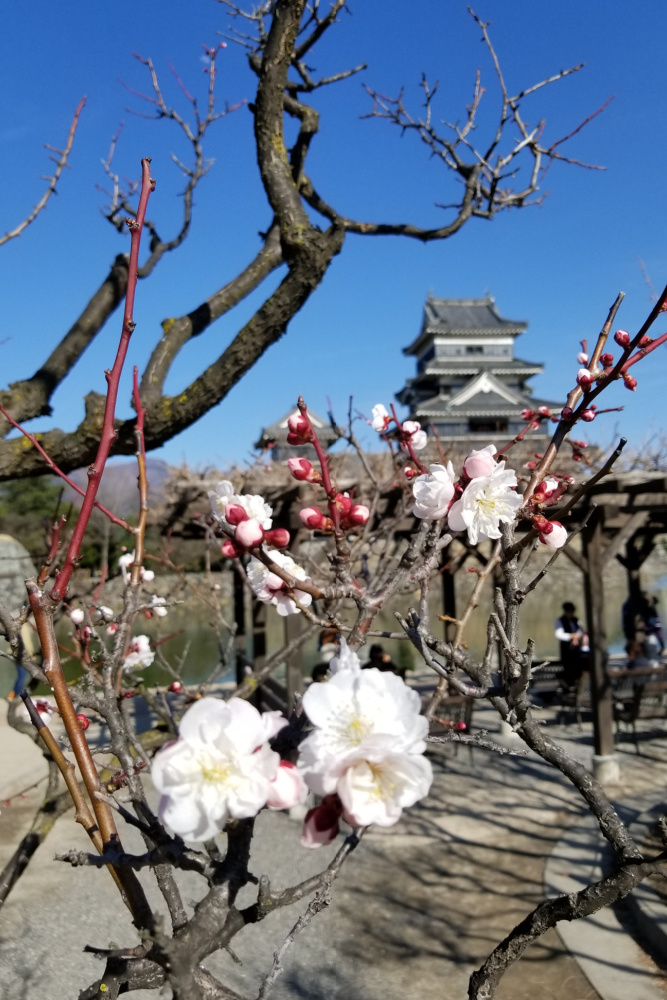
Traveling by train in Japan
Many stories have romanticized train travels wrapped in nostalgia.
However, beyond the poetry, it remains one of the most authentic and sustainable ways to explore a country.
During this trip, I could move around freely and comfortably by train, use public transportation, and walk a lot—something I love! All of this without needing a car.
I hope that in the future, more trains will take us to explore the beautiful places on our planet, making travel accessible to more people.
If you’re considering discovering Japan by train, this itinerary is a great place to start.
And, of course, I hope to return to Japan!
- To get from Takayama to Shirakawa-go, I used Japan Bus Online. I had doubts before booking, so I contacted customer service, who helped me complete the purchase. If, for any reason, you are unable to book through them, you can also try Nohi Bus. The journey takes about an hour. ↩︎
Related articles
If you loved this slow and scenic route through Japan, here are more mindful travel experiences across Asia:
7-Day Sumatra Itinerary – Orangutans, Jungle Treks & Pulau Weh Beaches
Yangmingshan Hike in Taiwan – Volcanic Views & Verdant Hills
Charming City of Gyeongju in South Korea – History, Temples & Slow Travel
Staying with the Uros – A Sustainable Experience on Lake Titicaca
How to Choose a Sustainable Accommodation – Travel That Gives Back
Enjoyed this itinerary? Share it with a friend who’s dreaming of Japan 🇯🇵
Pin this article

If you enjoy temple-hopping, explore my Angkor Wat 3-Day Itinerary for a deep dive into Cambodia’s history.

